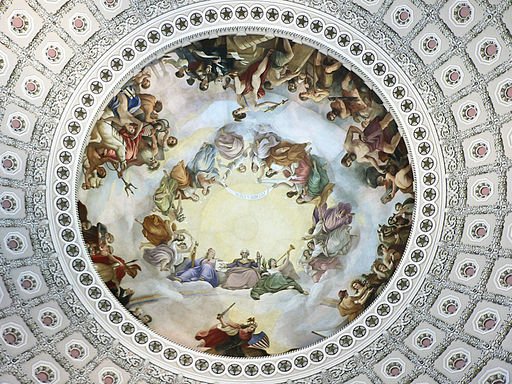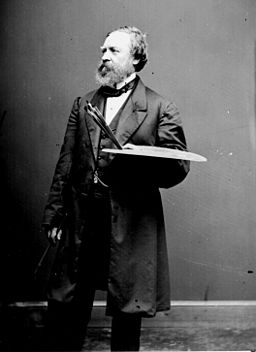You Are Standing in the Rotunda of the U.S. Capitol - Now Look Up
You Enter The Rotunda Through The Columbus Doors

You walk to the center, directly under the Capitol Dome, you look up and there it is, 180 feet above you is The Apotheosis of George Washington, a fresco painting by Constantino Brumidi, an Italian immigrant (seen below) who arrived in the United States in 1852. He painted the Apotheosis over a period of 11 months, immediately following the Civil War. The painting is huge, covering an area of 4,664 square feet. And the trompe-l'œil figures you see in the image above are 15 feet tall. Brumidi was born and trained in.....take a guess, that's right, Rome. Now I've been to Rome and the one thing Rome is full of is Churches, Catholic Churches. And when you look up in those Churches, you see Heaven, the abode of God to the Christian. The English word ceiling comes from the Latin caelum, "heaven or sky." There are no corners or straight lines in a dome, nor in nature. The dome is architectural metaphysics, the closest man could come to the spiritual world with bricks, mortar and plaster. This explains why churches built during the baroque period featured fresco paintings of Heaven in the same style as you see in the US Capitol Dome. Yet Brumidi left out one important feature when he mimicked the domes of Catholic Churches...God. Well, not really. Brumidi's theme is mythological, pagan even, and in it George Washington is God, or a god. Now at the risk of sounding like a broken record, let's go over again what we have discovered in previous posts. We learned that the Dome on the U.S. Capitol traces its origins to a Renaissance architect named Donato Bramante and his Tempietto in Rome. And also, that domes were associated in the ancient world with the gods and the afterlife, and probably for that reason were christianized by the Catholic Church and incorporated into Church architecture. Centuries passed. Then came the Enlightenment and the French Revolution, when the domed Church of St. Genevieve became caught in a struggle between the anti-clerical secularists and the Catholic Church. By 1885 the struggle was over, the Church of St. Genevieve since then being known as the Paris Pantheon. We then explored the backstory to the Columbus Doors that give entry to the Rotunda directly below the U.S. Capitol dome. We learned that the Columbus Doors were essentially copied by a man named Randolph Rogers from Ghiberti's Doors that hang on the Florence Baptistery.
This brings us up to date and to Brumidi's fresco painting on the ceiling of the Capitol Dome titled The Apotheosis of George Washington. The following is the definition of Apotheosis taken from oxforddictionaries.com: The elevation of someone to divine status, from apotheoun ‘make a god of’, from apo ‘from’ theos ‘god’. This is where it gets weird. Julius Caesar and all of the Roman Emperors after him were apotheosized, which begs the question, how does a painting titled The Apotheosis of George Washington end up on the ceiling of a Dome resting above the Capitol of a secular nation founded on enlightenment principles, and a Republican form of Government? Think about it, Julius Caesar overthrew the Roman Republic and ushered in an Imperial Cult. Consider this excerpt about Julius Caesar taken from a Wikipedia article: ".....his portrait was put on the coins (the first time a living man had appeared on Roman coinage). Early in 44 BC, he was called parens patriae (father of the fatherland); his birthday was made a public festival; In Cicero's hostile account, the living Caesar's honours in Rome were already and unambiguously those of a full-blown god."
Now I'm not trying to get all Dan Brown - Da Vinci Code here, but I live in the United States, and the subject of the Apotheosis is on our coins and fiat currency, Washington’s birthday is a National Holiday (etymology is holy day), and Washington is referred to as the Father of our Country. These are not coincidences. Check out what the site, Architect of the Capitol, says about Brumidi's painting of Washington's Apotheosis: "Brumidi depicted George Washington Rising to the heavens in glory, "apotheosis" in the title means literally the raising of a person to the rank of a god"

Above, for the sake of comparison, you can see a fresco painting that decorates the dome of a Baroque Church in Bavaria. I chose this photo because its in public domain, but any number of baroque Catholic Churches would demonstrate the same point. That the architects and designers who built Washington D.C. went out of their way to mimic, copy, integrate, whatever you want to call it, the beauty, grandeur, and even the spiritual aspects of Roman Catholic Churches, while at the same time incorporating neo-classical designs inspired by Andrea Palladio and Sebastiano Serlio. And if it ended there I think we could safely say that it was merely artistic license that led to the cross pollination of secular and sacred in the eponymously named Capital of the USA. But it doesn't end there. The men who made the decisions to cross the line of style and into metaphysics did so knowingly. They were well read, educated people. They knew the history of ancient Rome. It would have made much more sense for them to have purposely avoided any reference to the tyrant Julius Caesar, whose hubris transformed a functioning ancient republic into a tyranny. Fast forward to Ford's Theater and John Wilkes Booth, the assassin of Abraham Lincoln. He was a popular actor who performed in Shakespeare's Julius Caesar many times. When he shot the President he cried out “Sic semper tyrannis! (Ever thus to tyrants!)” as he jumped onto the stage and fled on horseback. So I ask, were the seeds of Empire sown very early in America? Was the American Empire and the Imperial Presidency that we have today, not only inevitable, but part of the original design? I suspect it was.
Also, the United States in the 19th century was almost entirely Protestant, iconoclastic, and very suspicious of what was termed at the time, Popishness. Anti-Catholic sentiment lasted until the 1960's when John F. Kennedy, an Irish Catholic, and to this day the only Catholic to become President, had to address his Catholicism during his campaign. Would he be obedient to the Constitution or the Pope? was the worry of many Americans, as ridiculous as that sounds in 2018. Anti-Catholic leagues popped up during the great wave of southern European immigration (1890-1920), partly due to the Catholic beliefs of the immigrants. With all of this background, why did the men building and decorating the Capital City of a secular government borrow so heavily and directly, not only from religious imagery, but from a religion they considered alien to their own?
Constantino Brumidi had primarily two patrons throughout his entire career, the Catholic Church and the United States Government. Could it be any clearer? In addition to his work on the Capitol Dome and other Government commissions Brumidi painted the Crucifixion, Martyrdom of St. Stephen, and the Assumption of Mary for St. Stephen's Church. He also worked on the Cathedral-Basilica of St. Peter and St. Paul in Philadelphia where he did paintings of, no surprise here, St. Peter and St. Paul. He painted a fresco in St. Ignatius Church in Baltimore, and a painting of Saint Aloysius Gonzaga and Saint Charles Borromeo that hangs above the altar of St Aloysius Church in Washington.

Interesting post. I've read about the Apotheosis of George Washington somewhere, but yours is quite explanatory. Great writing!
Thank you Camilus.
very nice post, keep it up. make sure to check my art page too. artists need to come together on this platform to make a very big impact.